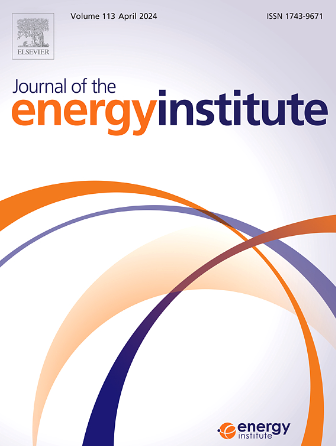氨煤共烧还原区NH3还原NO的关键反应途径:实验与DFT相结合的研究
IF 5.6
2区 工程技术
Q2 ENERGY & FUELS
引用次数: 0
摘要
氨作为零碳燃料,也是氮氧化物的还原剂。在氨煤共烧过程中,氨和氮氧化物的反应温度窗和气氛通常与SCR或SNCR不同,从而抑制了NH3对NO的还原作用。进一步探索更宽温度范围、不同氧浓度下NO还原的反应机理和动力学特征,对于优化煤粉锅炉氨共烧过程的反应环境,减少氮氧化物排放具有重要意义。为探索高温还原气氛下NH3还原NO的特性,在0-3% O2条件下,在1273-1773 K的一维管式反应器上进行了实验。研究了温度和氧气对脱氮效率的影响。分析了该条件下骨架反应的详细机理。实验结果表明,随着O2浓度的降低,NO还原的温度窗口向高温方向移动,最大NO还原效率提高。化学动力学模拟结果表明,提高O2浓度或温度可以促进NH3+OH=NH2+H2O和NH2+OH=NH+H2O的反应,促进NH2和NH自由基的形成。在高温还原气氛下,NH2和NH自由基对NO的还原至关重要。DFT计算表明,NH2还原NO的过程是NH2与NO结合生成H2NNO, H2NNO中的一个H原子转移到O原子上生成HNNOH。HNNOH的分解产生不同的产物,一方面,HNNOH中的O-N键断裂形成NNH和OH自由基,另一方面,HNNOH中的H原子从N原子转移到O原子上形成N2和H2O。NH还原NO的过程是NH与NO结合生成HNNO, HNNO分解生成不同的产物。一方面,HNNO中的H- n键断裂形成H自由基和N2O,另一方面,HNNO中的H原子与O原子靠近成键形成N2和OH自由基。在1273 ~ 1773 K时,NH2还原NO的反应速率常数为107 ~ 1010s−1,NH2自由基氧化和NH2转化为NH2的反应速率常数较低。当环境中存在微量氧时,OH和NH2自由基的浓度会大大增加,优先发生反应速率常数较大的NO还原。因此,在高温还原气氛下可以获得较高的NO还原效率。本文章由计算机程序翻译,如有差异,请以英文原文为准。

Key reaction pathways for NO reduction by NH3 in the reduction zone during ammonia-coal co-firing: A combined experimental and DFT study
Ammonia, as a zero-carbon fuel, is also a reducing agent for nitrogen oxides. During ammonia-coal co-firing, the reaction temperature window and atmosphere for ammonia and nitrogen oxides are usually different from those in SCR or SNCR, thus inhibiting the reduction effect of NH3 on NO. It is of great significance to further explore the reaction mechanism and kinetic characteristics of NO reduction with a wider temperature range and different oxygen concentration for optimizing the reaction environment and reducing nitrogen oxide emissions during ammonia co-firing processes in pulverized coal boilers. To explore the characteristics of NO reduction by NH3 under high-temperature reducing atmosphere, experiments were carried out on a one-dimensional tubular reactor at 1273–1773 K in 0–3% O2. The effects of temperature and oxygen on the denitrification efficiency were investigated. The detailed mechanism was analyzed to obtain the skeleton reactions under the present conditions. Experimental results showed that as the O2 concentration decreases, the temperature window for NO reduction shifts towards higher temperatures, and the maximal NO reduction efficiency is improved. The results of chemical kinetic simulation indicated that increasing O2 concentration or temperature can promote the reaction of NH3+OH=NH2+H2O and NH2+OH=NH+H2O, and promote the formation of NH2 and NH radicals. NH2 and NH radicals are essential for NO reduction under high-temperature reducing atmosphere. DFT calculations revealed that the process of NO reduction by NH2 is that NH2 combines with NO to form H2NNO, and then a H atom in H2NNO is transferred to O atom to form HNNOH. The decomposition of HNNOH produces different products, on the one hand, the O-N bond in HNNOH is broken to form NNH and OH radicals, on the other hand, the H atom in HNNOH is transferred from the N atom to the O atom to form N2 and H2O. The process of NO reduction by NH is that NH combines with NO to form HNNO, and HNNO decomposes to produce different products. On the one hand, the H-N bond in HNNO is broken to form H radical and N2O, on the other hand, the H atom in HNNO is close to and bonded with the O atom to form N2 and OH radical. At 1273–1773 K, the reaction rate constant of NO reduction by NH2 is in the range of 107-1010 s−1, and the reaction rate constant of NH2 radical oxidation and NH2 conversion to NH is lower. When there is trace oxygen in the environment, the concentration of OH and NH2 radicals can be greatly increased, and NO reduction with a large reaction rate constant can occur preferentially. Therefore, a higher NO reduction efficiency can be obtained under high-temperature reducing atmosphere.
求助全文
通过发布文献求助,成功后即可免费获取论文全文。
去求助
来源期刊

Journal of The Energy Institute
工程技术-能源与燃料
CiteScore
10.60
自引率
5.30%
发文量
166
审稿时长
16 days
期刊介绍:
The Journal of the Energy Institute provides peer reviewed coverage of original high quality research on energy, engineering and technology.The coverage is broad and the main areas of interest include:
Combustion engineering and associated technologies; process heating; power generation; engines and propulsion; emissions and environmental pollution control; clean coal technologies; carbon abatement technologies
Emissions and environmental pollution control; safety and hazards;
Clean coal technologies; carbon abatement technologies, including carbon capture and storage, CCS;
Petroleum engineering and fuel quality, including storage and transport
Alternative energy sources; biomass utilisation and biomass conversion technologies; energy from waste, incineration and recycling
Energy conversion, energy recovery and energy efficiency; space heating, fuel cells, heat pumps and cooling systems
Energy storage
The journal''s coverage reflects changes in energy technology that result from the transition to more efficient energy production and end use together with reduced carbon emission.
 求助内容:
求助内容: 应助结果提醒方式:
应助结果提醒方式:


